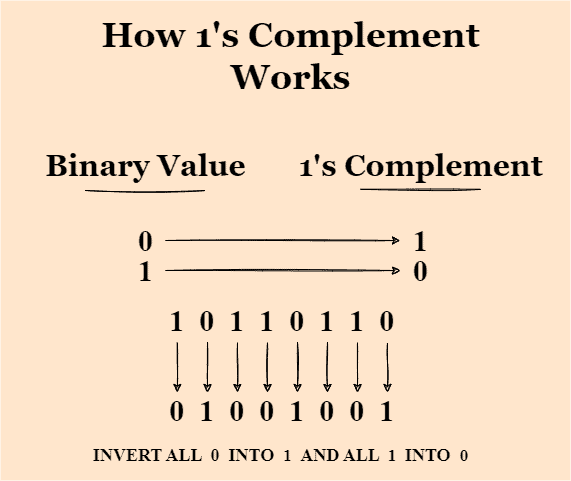1. 概述
在本篇教程中,我们将讨论如何使用 1’s Complement(一的补数) 技术来检测数据传输中的错误。
同时,我们会通过一个实际的例子来演示如何应用该技术进行错误检测。
2. 1’s Complement 简介
在数字系统中,数据完整性(Data Integrity)至关重要,因此我们需要一种可靠的方法,在数据到达目的地之前检测其是否出错。1’s Complement 是一种常用且高效的错误检测技术。
在 1’s Complement 系统中,每个二进制位都会被取反。也就是说,将一个二进制数中的 1 变成 0,0 变成 1。例如,二进制数 10110110 的 1’s Complement 是 01001001:

除了用于错误检测外,1’s Complement 还可用于计算机中负数的表示。它允许使用标准电路进行二进制加减法运算,也简化了某些位操作(如按位取反 ~ 和位移操作)的实现。
此外,1’s Complement 还可用于计算校验和(Checksum),以及在十进制与二进制转换时识别最高有效位(MSB)和最低有效位(LSB)。如果要对一个十进制数取 1’s Complement,通常的做法是先将其转换为二进制,再对每一位取反。
3. 使用 1’s Complement 进行错误检测
在介绍如何使用 1’s Complement 技术进行错误检测之前,我们先来看一下数据传输过程中可能出现的几种常见错误类型:
- ✅ 单比特错误(Single-bit error):仅一个比特位出错。
- ✅ 突发错误(Burst error):连续多个比特位出错。
- ✅ 时序错误(Timing error):由于传输时序不匹配导致的错误。
- ✅ 数据损坏(Corruption):数据在传输过程中被破坏。
1’s Complement 技术主要用于检测单比特错误。
举个例子,假设 A 要发送一段消息给 B:
- A 将原始消息转换为二进制;
- 计算该二进制的 1’s Complement;
- 同时发送原始消息和其 1’s Complement 给 B;
- B 接收到后,将消息还原为二进制;
- 再次计算其 1’s Complement;
- 如果两次结果一致,则说明传输无误;
- 若不一致,则说明传输过程中发生了错误。
⚠️ 1’s Complement 无法定位错误位置,但可以判断是否出错。
4. 实例演示
我们来看一个实际的例子来说明 1’s Complement 的错误检测流程。
假设计算机 A 发送两个二进制数据给计算机 B:
1001100111100010
A 首先对这两个二进制数进行加法运算:
10011001
+ 11100010
= 101111011
由于是 8 位系统,最高位进位需要加回到结果中:
01111011
+ 1
= 01111100
然后对结果 01111100 取 1’s Complement 得到 10000011,这个值就是校验和。
A 将原始数据 10011001、11100010 和校验和 10000011 一起发送给 B。
B 收到后再次计算:
10011001
+ 11100010
= 01111100 (加上进位后)
再将结果与校验和相加:
01111100
+ 10000011
= 11111111
如果最终结果是全 1(即 1’s Complement 表示为 0),则说明没有错误;否则存在错误。
✅ 如果结果为 00000000,说明无错误;
❌ 如果结果不为全 0,说明有错误。
如下图所示:

5. 优点与缺点
✅ 优点
- 计算速度快:相比奇偶校验(Parity)或校验和(Checksum),1’s Complement 涉及的运算更少;
- 无需额外比特:不像奇偶校验需要添加额外一位,也不像某些校验和方法那样增加额外开销;
- 实现简单:适合在硬件中实现,成本低。
❌ 缺点
- 检测能力有限:只能检测单比特错误和部分双比特错误,无法检测三比特及以上错误;
- 无法纠正错误:虽然可以检测错误,但不能自动纠正;
- 零的表示不唯一:在 1’s Complement 中,0 可以表示为全 0 或全 1,这在某些场景下可能导致歧义。
6. 总结
本文介绍了如何使用 1’s Complement 技术 来检测数据传输过程中的错误,并通过一个具体的例子演示了其实现过程。
虽然 1’s Complement 有其局限性(如不能检测所有类型的错误),但由于其实现简单、计算速度快,仍然是许多系统中常用的错误检测手段之一。
在实际开发中,如果你对性能要求较高但容忍一定程度的漏检风险,1’s Complement 仍然是一个不错的选择。不过如果你需要更强的错误检测能力,建议考虑使用 CRC 或更复杂的校验机制。